Jianianhualong
| Jianianhualong | |
|---|---|
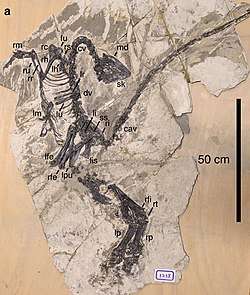 | |
| Type specimen of J. tengi | |
| Scientific classification | |
| Kingdom: | Animalia |
| Phylum: | Chordata |
| Clade: | Dinosauria |
| Order: | Saurischia |
| Suborder: | Theropoda |
| Family: | †Troodontidae |
| Genus: | †Jianianhualong Xu et al., 2017 |
| Type species | |
| Jianianhualong tengi Xu et al., 2017 | |
Jianianhualong (meaning "Jianianhua dragon") is a genus of troodontid theropod dinosaur from the Early Cretaceous of China. It contains a single species, Jianianhualong tengi, named in 2017 by Xu and colleagues based on an articulated skeleton preserving feathers. The feathers at the middle of the tail of Jianianhualong are asymmetric, being the first record of asymmetrical feathers among the troodontids. Despite aerodynamic differences from the flight feathers of modern birds, the feathers in the tail vane of Jianianhualong could have functioned in drag reduction whilst the animal was moving. The discovery of Jianianhualong supports the notion that asymmetrical feathers appeared early in the evolutionary history of the Paraves.
Jianianhualong possesses a combination of traits seen in basal as well as traits seen in derived troodontids. This is consistent with its phylogenetically intermediate position among the troodontids. This mixture of traits shows a distinct spatial organization, with basal traits being present in the forelimbs and pelvis, and derived traits being present in the skull and hindlimbs. This may represent a case of mosaic evolution, where natural selection acts upon the form of the body in a modular way. Similar transitional patterns of traits are seen in the troodontid Sinusonasus, a close relative of Jianianhualong. Ecologically speaking, Jianianhualong and Sinusonasus are part of the considerable diversity of troodontids that is present within the Yixian Formation.
Discovery and naming
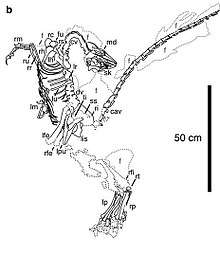
Jianianhualong is known from the type and only specimen, a nearly complete skeleton preserving feathers that is missing only the end of the tail. It is articulated and compressed on a stone plate. This holotype specimen is stored under the collection number DLXH 1218 in the Dalian Xinghai Museum, Liaoning Province, China. It was excavated using mechanical tools (geologist's hammers and chisels) from Early Cretaceous[1] rocks of the Yixian Formation in the locality of Baicai Gou (Chinese: 白菜溝), located in the Yixian County of Liaoning.[2] The Dakangpu Bed (equivalent to the Dawangzhangzi, Daxinfangzi, Hejiaxin, Sichakou, and Senjiru Beds),[3] which Baicai Gou is a part of,[4] is situated in the middle of the formation. The specific portion of the Beds from which Jianianhualong originates was dated in 2006 and 2008 to approximately 124.4 million years ago, which corresponds to the early Aptian.[5][6][7]
In 2017, Jianianhualong was named and described by a team of researchers including Xu Xing, Philip Currie, Michael Pittman, Xing Lida, Meng Qingjin, Lü Junchang, Hu Dongyu, and Yu Congyu, in a research paper published in Nature Communications. In order to investigate the preserved plumage of the specimen, Xu and colleagues made use of laser-stimulated fluorescence using a 405 nm laser.[8] The genus name combines the name of a company that sponsored the research of this taxon, Jianianhua (Chinese: 嘉年華), and the suffix long (Chinese: 龍), meaning "dragon". The specific name, tengi, honours Ms. Teng Fangfang who acquired the specimen and made it available for study.[2]
Description
The type specimen of Jianianhualong measures approximately 1 metre (3 ft 3 in) as preserved; since the back of the tail is missing, the animal would probably have been around 1.12 metres (3 ft 8 in) long in life. Scaling from a thighbone length of 11.7 cm (4.6 in), Xu et al. found that it weighed 2.4 kilograms (5.3 lb).[2][9] Despite its small size, the specimen was fully-grown, as indicated by the fusion of the sutures in the vertebrae.[2][10][11]
Skull
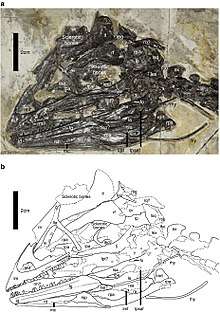
The skull of Jianianhualong is small. The jaw has about 75% of the length of the thighbone. It is roughly triangular when seen from the side, with a short snout and a wide skull roof like its relative Mei.[12] The short appearance of the snout is exaggerated somewhat by the fact that the front bones of the snout, the premaxillae, are lacking. The frontmost preserved bone in the fossil is the maxilla, the main body of which is taller than it is long. This distinguishes Jianianhualong from all other members of the Troodontidae,[13][14] along with the top margin of the bone forming a large angle of 45° with the bottom margin (its relative Saurornithoides has an angle of 6°,[15] and Sinovenator 36°[16]). There is a ridge on the backwards-extending jugal branch of the bone, unlike Byronosaurus,[17] Sinovenator,[16] Sinusonasus,[18] Xixiasaurus,[19] and Zanabazar,[15] but it is also accompanied by a groove (which is seen in Byronosaurus).[20] The relatively deep jugal branch unites Jianianhualong with derived (specialized) troodontids but not Sinovenator.[2][13][14]
Behind the maxilla, the depression in the skull wall known as the antorbital fossa is large and roughly triangular,[13] and bears two large openings (the antorbital fenestra and the elongated, enlarged maxillary fenestra) that stretch from the top margin to the bottom margin of the depression. This condition overall resembles that of derived troodontids[13][15][21] (Sinornithoides, Sinovenator, and Sinosunasus have one additional opening known as the promaxillary opening).[16][18][22] However, the rim of the fossa is sharp like that of Byronosaurus,[20][23] and the bar of bone separating the fenestrae is narrow as in Sinovenator.[14] Bordering the top and back of the depression is the T-shaped lacrimal, which has a long forward-projecting branch and a flange at the junction between the backwards-projecting and descending branches, much like with other troodontids.[24] The descending branch is nearly equal to the forward-projecting branch in length, longer than in other troodontids,[13] and the descending branch also bears a unique ridge on its front portion.[2]
The nasal bone is short and broad like with Mei,[12] and bears a row of foramina, small openings for arteries and nerves, like in other troodontids. Also like other troodontids, the frontal bone curves backwards smoothly on the outer margin which borders the eye socket.[13] On the bottom of the bone, there is a prominent ridge known as the crista cranii, which diverges gradually from the rim of the eye socket towards the midline of the back of the bone. The front tip of the ridge contacts the lacrimal, with a relatively simple joint unlike that of Stenonychosaurus ("Troodon").[25] The inner surface of the frontal suggests details about the braincase, including the widened olfactory tract and back of the cerebrum. Like other troodontids, there is a ridge on the forward-projecting branch of the jugal.[26] Also like other troodontids, there is a depression on the short and deep backward-projecting process, where it is overlapped by the quadratojugal bone.[14] The subtriangular and curved backward branch of the quadrate bone, which articulates with the pterygoid bone, is closer to the bottom of the bone than in most other non-bird theropods. Compared to Sinovenator, the long jugal branch of the postorbital bone is not as long.[2][14]
Lower jaws
Overall, the lower jaw is roughly triangular when viewed from the side, with a straight top margin and a curved bottom margin, and is not downturned unlike in Sinovenator.[14] The dentary, the tooth-bearing front lower jaw bone, is long (occupying half of the jaw's length), shallow, and triangular, and it bears a groove that widens towards the back of the bone, like in other troodontids.[13] Also typically troodontid are the many foramina towards the front of the dentary, which are particularly concentrated within the groove.[20] Further behind, there is a trough located near the back of the top surface of the surangular bone, which is not seen in other troodontids. The surangular borders the mandibular fenestra, the opening in the rear outer wall of the jaw, from above and behind. Below the fenestra, the angular bone divides the dentary and the mandibular fenestra by a robust forward-projecting branch that curves strongly upwards. This is seen in Sinovenator, other troodontids, and also some dromaeosaurids;[14] it may be a defining characteristic of troodontids or deinonychosaurians. On the inside of the jaw, the sub-triangular splenial bone does not have a V-shaped notch at the back, unlike that of Deinonychus and other theropods.[27] Behind the splenial, the prearticular bone curves towards the bottom of the jaw, with a thin blade at the front and a rounded shaft at the back. This is similar to other maniraptorans, the larger group to which troodontids belong.[2]
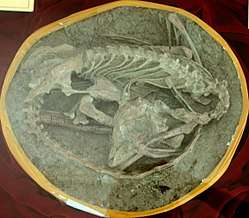
Teeth
The maxillae of Jianianhualong, its main upper jaw bones, bear 21 teeth on each side, while the dentaries bear 25 on each side. The number in the premaxillae is unknown, though likely to have been four per side. Like those of other troodontids, the teeth are strongly recurved and unevenly distributed.[13] The teeth at the front of the jaws are closely packed, while they are smaller and more spaced out at the back of the jaws. Characteristic of troodontids, the teeth are short-crowned, with height-to-width ratios decreasing from 1.5 (first tooth) to 1.2 (sixth tooth) along the jaw. The teeth near the front of the jaws lack serrations, while teeth further back have serrations on their back edges. These serrations are fine, as in Sinovenator,[14] instead of robust as in derived troodontids.[13] Similar to contemporary troodontids, the last maxillary tooth is located near the back end of the jugal branch of the maxilla, which is much further back than most coelurosaurs. Unusually, unlike the maxillary teeth, several frontmost teeth in the dentary appear to be angled forwards: they are "procumbent". This condition is present in several dromaeosaurids contemporary to Jianianhualong, even though they are not close relatives.[2][14]
Axial skeleton
The vertebral column of the fossil of Jianianhualong is nearly complete. However, individual vertebrae are not always easily discerned. The neck (i.e. the cervical vertebrae) is 16 cm (6.3 in) long, the torso (i.e. the dorsal vertebrae) is 17 cm (6.7 in) long, and the tail (i.e. the caudal vertebrae) is 54 cm (21 in) long. Overall, the tail would have been 3.9 times the length of the thighbone; there may have been 31 caudal vertebrae in total.[2]
Neck
Uniquely among troodontids, the upwards pointing neural spine of the axis, the second neck vertebra, has a convex top margin, and the back portion is strongly expanded. The third neck vertebra has a moderate centrum (vertebral body) length of 12 mm (0.47 in), and has a short neural spine. Associated but detached from this cervical is the third neck rib, which is long and slender, and overlaps both the third and fourth neck vertebrae. The fourth neck vertebra is slightly longer with a more robust rib, and has a rectangular neural spine 1.5 times as long as it is tall. The fifth to seventh vertebrae have the greatest length, with the sixth and seventh bearing complex pneumatic (invaded by air sacs) systems of foramina (openings), fossae (depressions), and laminae (ridges) on their sides. Their corresponding ribs are slightly longer than their vertebral bodies. Further back, the remaining neck vertebrae are significantly shorter, and bear ribs with expanded heads of equal length to their vertebral bodies.[2]
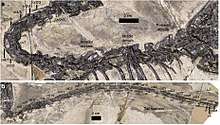
Trunk, ribs, and gastralia
The front vertebrae of the torso are relatively short, with the middle and back vertebrae being relatively longer. No pneumatic openings or depressions (pleurocoels) are present on the sides of the front vertebrae; the middle and back vertebrae were likely similar in this respect. The bodies of the middle and back vertebrae are low, with a length-height ratio of 2.0, like other small deinonychosaurs.[14] Like other basal (less specialized) members of the Paraves, the neural spines of the back are fan-shaped, with the neural spines belonging to the rear vertebrae attaching to the rear halves of the corresponding vertebral bodies.[14] None of the torso ribs has a bird-like uncinate process (a hook for the attachment of muscles assisting breathing) and the sternum or breastbone is also not ossified. This is similar to other troodontids.[13] Like Velociraptor and other theropods, the first pair of the gastralia (belly ribs) near the front of the torso is noticeably more robust, particularly in the central portion segments.[2][28]
Tail
Similar to other paravians, the vertebrae of Jianianhualong increase over the length of the tail; e.g., the ninth tail vertebra is 1.7 times the length of the eighth, while the fifteenth vertebra - among the longest, with a length of 23.3 mm (0.92 in) - is about twice as long as the sixth. From the twenty-third vertebra backwards, the sides become compressed such that they become sub-triangular instead of rectangular in cross-section; this transition occurs at two-thirds the length of the tail, as in Sinovenator. From the twenty-fourth vertebra backwards, the front articular surface of the vertebral bodies become deeper than the rear articular surface. There is no evidence of a groove on the bottom of the front tail bodies, though most coelurosaurs possess one. Like with other troodontids, the articular processes or zygapophyses of the tail vertebrae are small and nearly horizontal, instead of being long as in other tetanurans.[2][13]
There are neural spines on only the first eight tail vertebrae; it is unknown whether the neural spines are replaced by a groove further backwards in the series, as does happen in other troodontids.[13] On the underside of the tail, the chevrons, separate bones sticking out to below, are plate-like. The chevrons articulating with the first to fifth vertebrae are much taller than they are long; those articulating with the sixth to ninth vertebrae are longer than they are tall, although they are still relatively tall; and those articulating with the ninth, tenth, and further vertebrae are very shallow, and are somewhat flattened. On the vertebrae towards the back of the tail, the forward and backward projections of the chevrons are roughly equal in length. In these chevrons, the forward projection is blunt, while the backward projection is somewhat bifurcated or forked. Unlike in Sinusonasus, where all of the chevrons come into contact with each other,[18] there are some gaps between the chevrons of Jianianhualong.[2]
Limbs
Shoulder girdle and arm
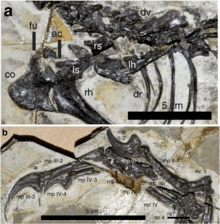
The scapula, the upper part of the shoulder girdle, which bears a strap-like blade and is roughly equal in length to the humerus (upper arm bone), is preserved at an angle of 40° relative to the long axis of the trunk vertebrae. This is more similar to articulated specimens of more basal theropods, as opposed to paravians, in which the scapula is nearly parallel to the vertebrae.[14] Like other members of the Pennaraptora, the large, four-sided coracoid,[29] the lower part of the girdle, is about 1.3 times as long as it is wide.[30] The bottom of the coracoid extends backwards with a hook-like projection, the postglenoid process, which is similar in length to that of Sinornithoides but longer than that of Sinovenator.[14] Unlike Sinornithoides,[31] the furcula is robust, flattened, and U-shaped like that of Mei.[2]
Like derived troodontids, the slender upper arm bone is about 70% of the length of the thighbone. On the upper arm bone, however, the deltopectoral crest, the bone plate serving for muscle attachment, is short compared to Linhevenator and other derived troodontids,[26] occupying only 20% of the shaft length. The ulna, the main lower arm bone, which is 88% of the length of the upper arm, exhibits a slight backward bow. Mei shows a much stronger bow,[12] whereas it is absent in most other troodontids altogether.[29] The olecranon of the ulna, the process for the attachment of muscles that stretch the arm, is mildly developed, and appears to be accompanied by a prominent flange further down on the bone. Compared to the ulna, the radius, the parallel lower arm bone, is slightly thinner, having a shaft diameter that is 76% of that of the ulna. Contrary to most other theropods, the top portion of the radius bears a backwards bow similar to that of the ulna.[2]
The hand bears three digits, typical of the Maniraptora, which respectively bear two, three, and four phalanges. The authors take the view that the three digits represent the second, third and fourth, whereas most other researchers see them as the first, second and third.[32] The overall length of the hand is 112 mm (4.4 in), 140% of the upper arm and 95% of the thighbone. In the wrist, the semilunate carpal, a flat curved bone, is relatively small; the top surface is strongly convex and bears a unique transverse groove. Among the three metacarpal bones of the middle hand, the end of metacarpal "IV" (corresponding to the third digit present) extends slightly beyond the end of metacarpal "III" (corresponding to the second digit present), which is otherwise not seen outside of the Avialae. However, enantiornithean birds such as Patagopteryx also possess this trait.[33] The top end of metacarpal "IV" is also situated further downward than that of metacarpal "III", which is the case for many paravians.[2]
Several distinguishing characteristics of Jianianhualong are found further down among the phalanges. Phalanx "II"-1 (the first phalanx of the first digit or finger) is unusually long, being just shorter than metacarpal "III"; it bears a "heel" at its top end, as well as a large groove on the interior surface that extends from the top of the bone for more than half its length. Additionally, phalanx "III"-2 is also very long, being longer than metacarpal "III", a trait that is only seen in basal ornithomimosaurs as well as the paravians Xiaotingia and Yixianosaurus.[30] The claws, or ungual phalanges, are highly robust, with their basal width being at least 50% of their overall length; the claw of the first finger is the largest. Like with dromaeosaurids, the small claw of the third finger has a slight upwards arch, but all of the claws on the hands of dromaeosaurids are arched.[2][34]
Pelvic girdle and hindlimb
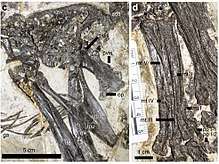
The pelvis of Jianianhualong is overall similar to that of Sinovenator. Like in Archaeopteryx and basal dromaeosaurids, the ilium, the top pelvis bone, is small, being 60% of the length of the thighbone.[35] Most other theropods have an ilium that is at least 70% of the length of the thighbone. Also unusually among theropods, the top margin of the ilium is concave. The forward-projecting "leg" of the ilium, the pubic peduncle, bears a large and forward-facing depression on its side, which serves as an attachment for the femoral protractor (moving the thighbone forwards) muscle known as musculus cuppedicus.[36] Below the ilium, the left and right pubic bones are conjoined into the unusually broad "pubic apron", a connecting bone sheet, that is characteristic of troodontids,[37] with a ridge on the back surface as in Sinovenator.[2]
Behind the pubic bone, the ischium is a short bony plate that has 48% of the length of the pubic bone. Like in basal dromaeosaurids and basal birds, there is an upwards-directed projection near the top of the rear edge of the ischium, where it articulates with the ilium.[35][38][39] Further down, the edge of the bone curves inwards, creating a hollow profile, followed by a second upwards projection (a combination also seen in Archaeopteryx). The forward-projecting obturator process on the front edge of the ischium is located near the bottom of the bone as in basal dromaeosaurids and basal birds, but it is small like that of Archaeopteryx. There is a small recess on the margin of the process; Buitreraptor and Sinornithosaurus have a similar but comparatively larger recess.[2]
Like with most theropods, the thighbone is curved forwards.[40] The bottom end of the thighbone is more robust than the top end, a trait shared with Anchiornis.[41] Among the four metatarsal bones of the middle foot, metatarsal II is the shortest and most slender, being 88% of the length of metatarsal III, asides from metatarsal I (corresponding to the hallux, or digit I). Metatarsal III has 72% of the length of the thighbone, which is shorter than the third metatarsal of Sinovenator which has 90% of the length of the thighbone. Unlike in other troodontids,[40] the bottom end of metatarsal II does not bear a hinge joint but is rounded, and a flange on the bottom of metatarsal IV is also missing; its being absent is a distinguishing characteristic of Jianianhualong. However, metatarsal IV is overall robust as in other troodontids.[40] Overall, the phalanges of the hallux are long, having together 31% of the length of metatarsal III; almost exactly the same ratio is present in Stenonychosaurus.[2]
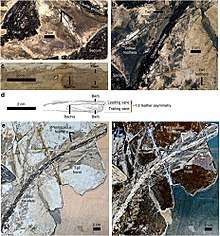
On the second toe of the foot (digit II), phalanx II-1, the first of the toe, has a tall top end, and is about 1.5 times the length of phalanx II-2, the second. Like in other derived deinonychosaurians, phalanx II-2 has a prominent "heel" at its top end, which is significantly extended.[28][27][42][43] The bottom end of phalanx II-2 bears extensions below and above the diameter of the shaft, a trait also seen in other troodontids and basal dromaeosaurids that would have enhanced the rotational arc of the joint.[44] Like derived troodontids and dromaeosaurids, the "sickle claw", the ungual of digit II, is strongly curved and bears a prominent flexor tubercle (an elevation serving as attachment for the tendon flexing the claw);[26][42] it is also much larger than the other phalanges in the second toe, being 1.4 times the length of phalanx II-1 whereas they have equal lengths in the foot of Sinovenator.[2]
Preserved feathering
Feathers are preserved alongside the entire vertebral column of Jianianhualong. However, only those along the tail show much detail. On the bottom of the neck, feathers are preserved with a length of at least 30 mm (1.2 in). Those along the back and over the hip are longer, with a length of about 75 mm (3.0 in). Behind the tibia or shinbone, there are also some feathers measuring 70 mm (2.8 in) in length. Additionally, some poorly preserved feathers are associated with the arm, both the humerus and ulna, having an unknown length.[2]
Like that of Jinfengopteryx, Anchornis, and Archaeopteryx, the tail of Jianianhualong supports a frond-like fan of pennaceous feathers along its entire length. Unlike Archaeopteryx and potentially Jinfengopteryx,[45][46] the feathers are curved, with at the end of the tail a convex front edge and a concave back edge; at the base of the tail it is the other way around. Feathers from the middle of the tail are 120 mm (4.7 in) long and at least 10 mm (0.39 in) wide. Like in Archaeopteryx, at least some of the long pennaceous feathers lining the tail are asymmetric; one feather at the middle of the tail has a trailing (hind) vane that is about twice as wide as the leading (front) vane, with the barbs being respectively at angles of 10° and 15° for the two vanes. In Archaeopteryx, the feathers at the end of the tail, which is not preserved in Jianianhualong, are symmetrical and have rounded tips.[2][46]
Classification
A number of characteristics allow Jianianhualong to be identified as a member of the Troodontidae. These include the long forward-projecting branch and flange of the lacrimal bonw; the foramina on the nasal bone; the smooth transition between the eye socket and the backward-projecting branch of the frontal bone; the ridge on the forward-projecting branch of the jugal bone; the triangular dentary bearing a widening groove; the robust forward-projecting branch of the surangular bone; the relatively large number of unevenly-distributed teeth; the flattened chevrons with blunt forward projections and bifurcated backward projections; and the broad and flat "pubic apron" formed by the pubic bones.[2][13]
Within the troodontids, Jianianhualong displays a unique combination of characteristics from both basal and derived troodontids, organized in distinct regions of its body. The forelimbs and pelvis largely resemble basal troodontids such as Sinovenator: the short deltopectoral crest on the humerus; the long hand, metacarpal II, and phalanx III-2 on the hand; the small ilium; the ridge on the pubic apron; and the short ischium with two projections and an obturator process near the bottom of the bone.[13][14] At the same time, the skull and hindlimbs resemble derived troodontids: the deep jugal branch of the maxilla bearing a prominent groove, the sub-triangular antorbital fossa; the relatively long maxillary fenestra; the short jugal branch of the postorbital bone; the long hallux; the slender and short metatarsal II; the "heel" on phalanx II-2; and the large, curved sickle claw.[13] Sinosonasus exhibits a similar condition: the skull is like those of basal troodontids, and the pelvis and hindlimb are like those of derived troodontids. Phylogenetically, Xu and colleagues found Jianianhualong in a polytomy with Sinusonasus and several other intermediate troodontids. The strict consensus tree recovered is reproduced below.[2]
|
|
The conjunction of basal and derived features as distinct regions of the body in Jianianhualong and Sinosonasus represent a possible case of mosaic evolution, in which evolutionary selection acts upon distinct "modules" of the body.[47] Indeed, the pattern in which basal and derived features are present seems to follow the domains of the body that are regulated by Hox genes, which have previously been discussed in the context of pterosaurs such as Darwinopterus.[48] However, this hypothesis is weakened by the presence of characteristics in both troodontids that do not follow the pattern. In Jianianhualong, for instance, the large antorbital fenestra, long tooth row of the maxilla, and finely-serrated teeth represent basal characteristics in an otherwise derived skull. Similarly, digit II of the foot in Sinusonasus is not as specialized as those of derived troodontids, despite the hindlimb being overall derived. Conversely, the forelimb of Jianianhualong is short overall as in derived troodontids, despite the presence of basal traits.[2]
An ancestral state reconstruction conducted along with the phylogenetic analysis (results labelled in the above phylogenetic tree) suggests that wing feather asymmetry evolved only once, at the last common ancestor of the Paraves. Asymmetrical tail feathers would then also have evolved once, at the common ancestor of all paravians excluding scansoriopterygids and avialans. However, given the uncertainty of whether dromaeosaurids possessed asymmetrical wing feathers, the support for a single emergence of asymmetrical wing feathers in the common ancestor of the Paraves is equivocal, the alternative scenario that it evolved twice being plausible. The distinct possibility thus remains that troodontids had asymmetrical tail feathers but symmetrical arm feathers, suggesting that asymmetry in the tail appeared first, but this is not supported by the ancestral state reconstruction.[2]
Paleobiology
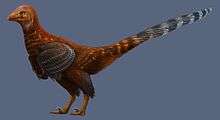
Feathering and aerodynamic implications
Jianianhualong preserves the first evidence of feathers in an unquestionable troodontid, with the troodontid affinities of taxa such as Anchiornis, Eosinopteryx, Jinfengopteryx, and Xiaotingia having been questioned by various studies.[45][49][50][51] Additionally, Jianianhualong represents the first record of asymmetrical feathers among troodontids, thus making troodontids the second group among non-avialan theropods to possess asymmetrical feathers; asymmetrical arm feathers are found in the microraptorians Microraptor, Changyuraptor, and possibly Zhenyuanlong.[52][53] Asymmetrical feathers are correlated with flight capabilities among paravians,[54] and their emergence marked a major step in the evolution of modern avian feathers.[55][56][57] This trait may have been selected for due to its augmentation of locomotion on the ground or in the air.[2][58]
However, the presence of asymmetrical feathers in Jianianhualong does not guarantee that it was capable of either gliding or powered flight.[59] The feathers in the tail of Jianianhualong could certainly have functioned in either maintaining feather stability (the barbs of the leading edge, having a low angle of 10°, augmented the vane's rigidity[60]) or controlling airflow (through the variation of the feathers' blade pitch).[61][62] However, these feathers differ from those of modern birds in that the barbs of the trailing edge also have a relatively low angle of approximately 15°. Thus, aerodynamically speaking, the feathers in the tail of Jianianhualong likely did not have the same function as those of modern birds.[59] Regardless, the subtriangular outline of the tail frond, as well as the slots separating the tips of individual feathers, would have provided drag reduction when the tail was in use.[2][63][64]
Paleoecology
After Mei, Sinovenator, Sinusonasus, and Jinfengopteryx, Jianianhualong is the fifth named troodontid that has been discovered in the Jehol Biota as a whole, with the first three other troodontids also originating from the Yixian Formation. With Jianianhualong and Sinusonasus representing "transitional" and more derived forms of troodontids compared to Mei and Sinovenator, the diversity of troodontids within the Jehol was appreciable.[2] Asides from troodontids, the Yixian Formation also preserves a diverse assemblage of other animals, both dinosaurian and non-dinosaurian. The hadrosauroid Jinzhousaurus is known from Baicai Gou, the same locality as that of Jianianhualong, as is the maniraptoran Yixianosaurus as well as hundreds of specimens from the choristodere Hyphalosaurus.
From elsewhere in the Dakangpu/Dawangzhangzi Beds, specimens have been discovered belonging to the birds Confuciusornis, Hongshanornis, Grabauornis, Liaoxiornis, Longicrusavis, Shanweiniao, Shenqiornis, and Zhongornis; the non-avialan theropod Sinosauropteryx; the ceratopsian Psittacosaurus; the pterosaur Cathayopterus; the lizards Dalinghosaurus and Yabeinosaurus; the choristoderes Hyphalosaurus and Monjurosuchus, of which the former is highly abundant; the turtle Manchurochelys; the mammals Acristatherium, Akidolestes, Chaoyangodens, Eomaia, Sinobaatar, and Sinodelphys; the frog Liaobatrachus; and fish, including Lycoptera (of which L. davidi is numerous), Peipiaosteus, and Protopsephurus.
Environmentally, Jianianhualong lived in a lacustrine area, as evinced by the tuffaceous sandstone present throughout the Dawangzhangzi Beds. Like the rest of the Yixian Formation, the environment represented by these assemblages was seasonally semi-arid, with a low mean air temperature of 10 ± 4 °C (50 ± 7 °F). The local flora consists of a mixed assemblage of gymnosperms, such as Czekanowskia, Schizolepis, and the ephedroids Amphiephedra, Chengia, Ephedrites, and Liaoxia; and also early angiosperms, including Archaefructus, Hyrcantha (formerly Sinocarpus), Leefructus, and Potamogeton. Leefructus in particular is a eudicot, being among the earliest records of the group.
See also
References
- ↑ Swisher, C.C.; Wang, X.; Zhou, Z.; Wang, Y.; Jin, F.; Zhang, J.; Xu, X.; Zhang, J.; Wang, Y. (2002). "Further support for a Cretaceous age for the feathered-dinosaur beds of Liaoning, China: New 40Ar/39Ar dating of the Yixian and Tuchengzi Formations". Chinese Science Bulletin. 47 (2): 136–139. doi:10.1360/02tb9031 (inactive 2018-09-11).
- 1 2 3 4 5 6 7 8 9 10 11 12 13 14 15 16 17 18 19 20 21 22 23 24 25 26 27 28 29 30 31 Xu, X.; Currie, P.; Pittman, M.; Xing, L.; Meng, Q.; Lü, J.; Hu, D.; Yu, C. (2017). "Mosaic evolution in an asymmetrically feathered troodontid dinosaur with transitional features". Nature Communications. 8: 14972. Bibcode:2017NatCo...814972X. doi:10.1038/ncomms14972. PMC 5418581. PMID 28463233.
- ↑ Wang, X.-L.; Zhou, Z.-H. (2008). "Mesozoic Pompeii". In Chang, M.-M.; Chen, P.-J.; Wang, Y.-Q.; Wang, Y.; Miao, D.-S. The Jehol Fossils: The Emergence of Feathered Dinosaurs, Beaked Birds and Flowering Plants (2nd ed.). Amsterdam: Academic Press. pp. 19–38. ISBN 9780123741738.
- ↑ Wang, X.-L.; Xu, X. (2001). "A new iguanodontid (Jinzhousaurus yangi gen. et sp. nov.) from the Yixian Formation of western Liaoning, China". Chinese Science Bulletin. 46 (19): 1669–1672. doi:10.1007/BF02900633.
- ↑ Sun, G.; Dilcher, D.L.; Wang, H.; Chen, Z. (2011). "A eudicot from the Early Cretaceous of China". Nature. 471 (7340): 625–628. Bibcode:2011Natur.471..625S. doi:10.1038/nature09811. PMID 21455178.
- ↑ Liu, Y.; Liu, Y.; Ji, S.; Yang, Z. (2006). "U-Pb zircon age for the Daohugou Biota at Ningcheng of Inner Mongolia and comments on related issues". Chinese Science Bulletin. 51 (21): 2634–2644. doi:10.1007/s11434-006-2165-2.
- ↑ Meng, F.X.; Gao, S.; Liu, X.M. (2008). "U-Pb zircon geochronology and geochemistry of volcanic rocks of the Yixian Formation in the Lingyuan area, western Liaoning, China". Geological Bulletin of China. 27: 364–373.
- ↑ Kaye, T.G.; Falk, A.R.; Pittman, M.; Sereno, P.C.; Martin, L.D.; Burnham, D.A.; Gong, E.; Xu, X.; Wang, Y. (2015). "Laser-Stimulated Fluorescence in Paleontology". PLoS ONE. 10 (5): e0125923. doi:10.1371/journal.pone.0125923. PMC 4446324. PMID 26016843.
- ↑ Campione, N.E.; Evans, D.C.; Brown, C.M.; Carrano, M.T. (2014). "Body mass estimation in non-avian bipeds using a theoretical conversion to quadruped stylopodial proportions". Methods in Ecology and Evolution. 5 (9): 913–923. doi:10.1111/2041-210X.12226.
- ↑ Brochu, C.A. (1996). "Closure of neurocentral sutures during crocodilian ontogeny: Implications for maturity assessment in fossil archosaurs". Journal of Vertebrate Paleontology. 16 (1): 49–62. doi:10.1080/02724634.1996.10011283.
- ↑ Irmis, R.B. (2007). "Axial skeleton ontogeny in the Parasuchia (Archosauria: Pseudosuchia) and its implications for ontogenetic determination in archosaurs". Journal of Vertebrate Paleontology. 27 (2): 350–361. doi:10.1671/0272-4634(2007)27[350:ASOITP]2.0.CO;2.
- 1 2 3 Xu, X.; Norell, M.A. (2004). "A new troodontid dinosaur from China with avian-like sleeping posture". Nature. 431 (7010): 838–841. Bibcode:2004Natur.431..838X. doi:10.1038/nature02898. PMID 15483610.
- 1 2 3 4 5 6 7 8 9 10 11 12 13 14 15 Makovicky, P.J.; Norell, M.A. (2004). "Troodontidae". In Weishampel, D.B.; Dodson, P.; Osmólska, H. The Dinosauria (2nd ed.). Berkeley: University of California Press. pp. 184–195.
- 1 2 3 4 5 6 7 8 9 10 11 12 13 14 Xu, X. (2002). Deinonychosaurian Fossils From the Jehol Group of Western Liaoning and the Coelurosaurian Evolution (Ph.D. thesis). Beijing: Graduate School of the Chinese Academy of Sciences. pp. 1–322.
- 1 2 3 Norell, M.A.; Makovicky, P.J.; Bever, G.S.; Balanoff, A.M.; Clark, J.M.; Barsbold, R.; Rowe, Timothy (2009). "A Review of the Mongolian Cretaceous Dinosaur Saurornithoides (Troodontidae: Theropoda)". American Museum Novitates. 3654: 1–63. doi:10.1206/648.1. hdl:2246/5973.
- 1 2 3 Xu, X.; Norell, M.A.; W., X.-L.; Makovicky, P.J.; Wu, X.-C. (2002). "A basal troodontid from the Early Cretaceous of China". Nature. 415 (6873): 780–784. Bibcode:2002Natur.415..780X. doi:10.1038/415780a. PMID 11845206.
- ↑ Bever, G.S.; Norell, M.A. (2009). "The perinate skull of Byronosaurus (Troodontidae) with observations on the cranial ontogeny of paravian theropods". American Museum Novitates. 3657: 1–51. doi:10.1206/650.1. hdl:2246/5980.
- 1 2 3 Xu, X.; Wang, X.-L. (2004). "A New Troodontid (Theropoda: Troodontidae) from the Lower Cretaceous Yixian Formation of Western Liaoning, China". Acta Geologica Sinica. 78 (1): 22–26. doi:10.1111/j.1755-6724.2004.tb00671.x.
- ↑ Lü, J.; Xu, L.; Liu, Y.; Zhang, X.; Jia, S.; Ji, Q. (2010). "A new troodontid (Theropoda: Troodontidae) from the Late Cretaceous of central China, and the radiation of Asian troodontids" (PDF). Acta Palaeontologica Polonica. 55 (3): 381–388. doi:10.4202/app.2009.0047.
- 1 2 3 Makovicky, P.J.; Norell, M.A.; Clark, J.M.; Rowe, T.E. (2003). "Osteology and relationships of Byronosaurus jaffei (Theropoda: Troodontidae)". American Museum Novitates. 3402: 1–32. doi:10.1206/0003-0082(2003)402<0001:oarobj>2.0.co;2. hdl:2246/2828.
- ↑ Senter, P.; Kirkland, J.I.; Bird, J.; Bartlett, J.A. (2010). "A New Troodontid Theropod Dinosaur from the Lower Cretaceous of Utah". PLoS ONE. 5 (12): e14329. Bibcode:2010PLoSO...514329S. doi:10.1371/journal.pone.0014329. PMC 3002269. PMID 21179513.
- ↑ Russell, D.; Dong, Z. (1993). "A nearly complete skeleton of a new troodontid dinosaur from the Early Cretaceous of the Ordos Basin, Inner Mongolia, People's Republic of China". Canadian Journal of Earth Sciences. 30 (10): 2163–2173. Bibcode:1993CaJES..30.2163R. doi:10.1139/e93-187.
- ↑ Norell, M.A.; Makovicky, P.J.; Clark, J.M. (2000). "A new troodontid theropod from Ukhaa Tolgod, Mongolia". Journal of Vertebrate Paleontology. 20 (1): 7–11. doi:10.1671/0272-4634(2000)020[0007:ANTTFU]2.0.CO;2.
- ↑ Xu, X.; Pittman, M.; Sullivan, C.; Choiniere, J.N.; Tan, Q.W.; Clark, J.M.; Norell, M.A.; Shuo, W. (2015). "The taxonomic status of the Late Cretaceous dromaeosaurid Linheraptor exquisitus and its implications for dromaeosaurid systematics". Vertebrata PalAsiatica. 53 (1): 29–62.
- ↑ Currie, P. J. (1985). "Cranial anatomy of Stenonychosaurus inequalis (Saurischia, Theropoda) and its bearing on the origin of birds". Canadian Journal of Earth Sciences. 22 (11): 1643–1658. Bibcode:1985CaJES..22.1643C. doi:10.1139/e85-173.
- 1 2 3 Xu, X.; Tan, Q.; Sullivan, C.; Han, F.; Xiao, D. (2011). "A Short-Armed Troodontid Dinosaur from the Upper Cretaceous of Inner Mongolia and Its Implications for Troodontid Evolution". PLoS ONE. 6 (9): e22916. Bibcode:2011PLoSO...622916X. doi:10.1371/journal.pone.0022916. PMC 3168428. PMID 21915256.
- 1 2 Ostrom, J.H. (1969). "Osteology of Deinonychus antirrhopus, an unusual theropod from the Lower Cretaceous of Montana". Peabody Museum of Natural History Bulletin. 30: 1–165.
- 1 2 Norell, M.A.; Makovicky, P.J. (1997). "Important features of the dromaeosaur skeleton: information from a new specimen". American Museum Novitates. 3215: 1–28. hdl:2246/3557.
- 1 2 Gauthier, J.A. (1986). Saurischian monophyly and the origin of birds. Memoirs of the California Academy of Sciences. 8. pp. 1–55. ISBN 978-0-940228-14-6.
- 1 2 Xu, X.; Sullivan, C.; Wang, S. (2013). "The systematic position of the enigmatic theropod dinosaur Yixianosaurus longimanus" (PDF). Vertebrata PalAsiatica. 51 (3): 169–183.
- ↑ Nesbitt, S.J.; Turner, A.H.; Spaulding, M.; Conrad, J.L.; Norell, M.A. (2009). "The theropod furcula". Journal of Morphology. 270 (7): 856–879. doi:10.1002/jmor.10724. PMID 19206153.
- ↑ Xu, X.; Clark, J.M.; Mo, J.; Choiniere, J.; Forster, C.A.; Erickson, G.M.; Hone, D.W.E.; Sullivan, C.; Eberth, D.A.; Nesbitt, S.; Zhao, Q.; Hernandez, R.; Jia, C.-K.; Han, F.-L.; Guo, Y. (2009). "A Jurassic ceratosaur from China helps clarify avian digital homologies". Nature. 459 (18): 940–944. Bibcode:2009Natur.459..940X. doi:10.1038/nature08124. PMID 19536256.
- ↑ Chiappe, L. (1996). "Late Cretaceous birds of southern South America: anatomy and systematics of Enantiornithes and Patagopteryx deferrariisi". In Arratia, G. Contributions of Southern South America to Vertebrate Paleontology. Munchner Geowissenschaftliche Abhandlungen, Reihe A, Geologie und Palaontologie. 30. Munich: Verlag Dr. Friedrich Pfeil. pp. 203–244.
- ↑ Senter, P.; Barsbold, R.; Britt, B.B.; Burnham, D.B. (2004). "Systematics and evolution of Dromaeosauridae (Dinosauria, Theropoda)". Bulletin of the Gunma Museum of Natural History. 8: 1–20.
- 1 2 Xu, X.; Zhou, Z.; Wang, X. (2000). "The smallest known non-avian theropod dinosaur" (PDF). Nature. 408 (6813): 705–708. Bibcode:2000Natur.408..705X. doi:10.1038/35047056. PMID 11130069.
- ↑ Rowe, T. (1986). "Homology and evolution of the deep dorsal thigh musculature in birds and other Reptilia". Journal of Morphology. 189 (3): 327–346. doi:10.1002/jmor.1051890310. PMID 29940710.
- ↑ Russell, D.A.; Dong, Z. (1993). "The affinities of a new theropod from the Alxa Desert, Inner Mongolia, People's Republic of China". Canadian Journal of Earth Sciences. 30 (10): 2107–2127. Bibcode:1993CaJES..30.2107R. doi:10.1139/e93-183.
- ↑ Xu, X.; Wang, X.-L.; Wu, X.-C. (1999). "A dromaeosaurid dinosaur with a filamentous integument from the Yixian Formation of China". Nature. 401 (6750): 262–266. Bibcode:1999Natur.401..262X. doi:10.1038/45769.
- 1 2 3 Norell, M.A.; Makovicky, P.J. (1999). "Important features of the dromaeosaurid skeleton II: information from newly collected specimens of Velociraptor mongoliensis". American Museum Novitates. 3282: 1–45. hdl:2246/3025.
- ↑ Xu, X.; Zhao, Q.; Norell, M.; Sullivan, C.; Hone, D.; Erickson, G.; Wang, X.; Han, F.; Guo, Y. (2009). "A new feathered maniraptoran dinosaur fossil that fills a morphological gap in avian origin". Chinese Science Bulletin. 54 (3): 430–435. doi:10.1007/s11434-009-0009-6.
- 1 2 Currie, P.J.; Peng, J. (1994). "A juvenile specimen of Saurornithoides mongoliensis from the Upper Cretaceous of northern China". Canadian Journal of Earth Sciences. 30 (10): 2224–2230. Bibcode:1993CaJES..30.2224C. doi:10.1139/e93-193.
- ↑ Xu, X.; Zhao, Ji; Sullivan, C.; Tan, Q.-W.; Sander, M.; Ma, Q.-Y. (2012). "The taxonomy of the troodontid IVPP V 10597 reconsidered" (PDF). Vertebrata PalAsiatica. 50 (2): 140–150.
- ↑ Xu, X.; Wang, X.-L. (2000). "Troodontid-like pes in the dromaeosaurid Sinornithosaurus" (PDF). Paleontological Society of Korea, Special Publication. 4: 179–188.
- 1 2 Foth, C.; Tischlinger, H.; Rauhut, O.W.M. (2014). "New specimen of Archaeopteryx provides insights into the evolution of pennaceous feathers". Nature. 511 (7507): 79–82. Bibcode:2014Natur.511...79F. doi:10.1038/nature13467. PMID 24990749.
- 1 2 Ji, S.; Ji, Q. (2007). "Jinfengopteryx compared to Archaeopteryx, with comments on the mosaic evolution of long-tailed avialan birds". Acta Geologica Sinica. 81 (3): 337–343. doi:10.1111/j.1755-6724.2007.tb00957.x.
- ↑ Brandon, R.N. (1999). "The Units of Selection Revisited: The Modules of Selection". Biology and Philosophy. 14 (2): 167–180. doi:10.1023/A:1006682200831.
- ↑ Lü, J.; Unwin, D.M.; Jin, X.; Liu, Y.; Ji, Q. (2010). "Evidence for modular evolution in a long-tailed pterosaur with a pterodactyloid skull". Proceedings of the Royal Society B. 277 (1680): 383–389. doi:10.1098/rspb.2009.1603. PMC 2842655. PMID 19828548.
- ↑ Godefroit, P.; Cau, A.; Hu, D.-Y.; Escuillié, F.; Wu, W.; Dyke, G. (2013). "A Jurassic avialan dinosaur from China resolves the early phylogenetic history of birds". Nature. 498 (7454): 359–362. Bibcode:2013Natur.498..359G. doi:10.1038/nature12168. PMID 23719374.
- ↑ Xu, X.; You, H.; Du, K.; Han, F. (2011). "An Archaeopteryx-like theropod from China and the origin of Avialae" (PDF). Nature. 475 (7357): 465–470. doi:10.1038/nature10288. PMID 21796204.
- ↑ Agnolín, F.L.; Novas, F.E. (2013). Avian Ancestors: A Review of the Phylogenetic Relationships of the Theropods Unenlagiidae, Microraptoria, Anchiornis and Scansoriopterygidae. SpringerBriefs in Earth System Sciences. Springer Netherlands. pp. 1–96. doi:10.1007/978-94-007-5637-3. ISBN 978-94-007-5636-6.
- ↑ Xu, X.; Zhou, Z.; Wang, X.; Kuang, X.; Zhang, F.; Du, X. (2003). "Four-winged dinosaurs from China". Nature. 421 (6921): 335–340. Bibcode:2003Natur.421..335X. doi:10.1038/nature01342. PMID 12540892.
- ↑ Lü, J.; Brusatte, S.L. (2015). "A large, short-armed, winged dromaeosaurid (Dinosauria: Theropoda) from the Early Cretaceous of China and its implications for feather evolution". Scientific Reports. 5: 11775. Bibcode:2015NatSR...511775L. doi:10.1038/srep11775. PMC 4504142. PMID 26181289.
- ↑ Feduccia, A.; Tordoff, H.B. (1979). "Feathers of Archaeopteryx: Asymmetric Vanes Indicate Aerodynamic Function". Science. 203 (4384): 1021–1022. Bibcode:1979Sci...203.1021F. doi:10.1126/science.203.4384.1021. PMID 17811125.
- ↑ Xu, X.; Zhou, Z.; Dudley, R.; Mackem, S.; Chuong, C.-M.; Erickson, G.M.; Varricchio, D.J. (2014). "An integrative approach to understanding bird origins". Science. 346 (6215): 1253293. doi:10.1126/science.1253293. PMID 25504729.
- ↑ Xu, X.; Guo, Y. (2009). "The origin and early evolution of feathers: insights from recent paleontological and neontological data". Vertebrata PalAsiatica. 47 (4): 311–329.
- ↑ Prum, R.O (1999). "Development and Evolutionary Origin of Feathers". Journal of Experimental Zoology Part B: Molecular and Developmental Evolution. 285 (4): 291–306. doi:10.1002/(SICI)1097-010X(19991215)285:4<291::AID-JEZ1>3.0.CO;2-9. PMID 10578107.
- ↑ Dececchi, T.A.; Larsson, H.C.E.; Habib, M.B. (2016). "The wings before the bird: an evaluation of flapping-based locomotory hypotheses in bird antecedents". PeerJ. 4: e2159. doi:10.7717/peerj.2159. PMC 4941780. PMID 27441115.
- 1 2 Feo, T.J.; Field, D.J.; Prum, R.O. (22 March 2015). "Barb geometry of asymmetrical feathers reveals a transitional morphology in the evolution of avian flight". Proceedings of the Royal Society of London B: Biological Sciences. 282 (1803): 20142864. doi:10.1098/rspb.2014.2864. ISSN 0962-8452. PMC 4345455. PMID 25673687.
- ↑ Ennos, A.; Hickson, J.; Roberts, A. (1995). "Functional morphology of the vanes of the flight feathers of the pigeon Columba livia". Journal of Experimental Biology. 198: 1219–1228.
- ↑ Norberg, U.M. (1995). "How a Long Tail and Changes in Mass and Wing Shape Affect the Cost for Flight in Animals". Functional Ecology. 9 (1): 48–54. doi:10.2307/2390089. JSTOR 2390089.
- ↑ Norberg, R.A. (1995). "Feather asymmetry in Archaeopteryx". Nature. 374 (6519): 211. Bibcode:1995Natur.374..211M. doi:10.1038/374211a0.
- ↑ Thomas, A.L.R. (1997). "On the Tails of Birds". BioScience. 47 (4): 215–225. doi:10.2307/1313075. JSTOR 1313075.
- ↑ Tucker, V.A. (1995). "Drag reduction by wing tip slots in a gliding Harris' hawk, Parabuteo unicinctus". Journal of Experimental Zoology. 198: 775–781.
